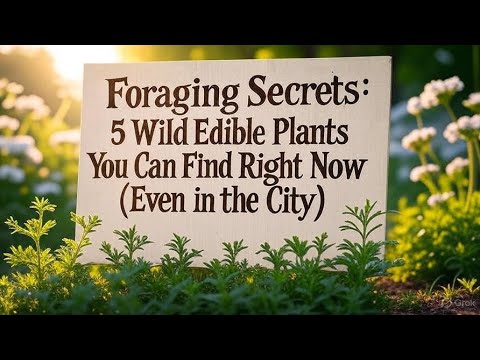Step outside and unlock nature’s hidden pantry! In this video, the Soil Doctor reveals 5 wild edible plants you can find right now—in urban parks, trails, or even your backyard.
Learn what to look for, how to safely identify them, and why foraging is a powerful way to reconnect with the land.
📌 Caution: Always double-check plant ID and forage responsibly.
🔔 Subscribe to Dirt Decoded for smart, soil-first gardening—and wild food wisdom too.
#Foraging #WildEdibles #UrbanForaging #EatWild #SurvivalPlants #DirtDecoded #SoilDoctor #BackyardForaging
FAQs:
Q1: Do I need permission to forage?
A: Yes—always check local laws. Foraging is often allowed in public spaces, but some parks and private lands may restrict it.
Q2: Is it safe to eat wild plants?
A: Only if properly identified! Mistaking toxic plants for edible ones can be dangerous. Use field guides or forage with experts.
Q3: Can I forage in the city?
A: Absolutely—look in clean, pesticide-free areas like parks or edges of walking trails.
Q4: What tools do I need?
A: Just a small bag, gloves, a field guide or ID app, and clean scissors or pruners.
Q5: Are these plants available year-round?
A: Availability depends on your region and season. Some greens and roots are spring/summer-only, others grow year-round.
🎥 Video
hey garden friend welcome back to dirt decoded smarter soil better gardens I’m the soil doctor and today I want to take you on a walk that goes beyond your usual garden beds We’re heading out into the wild to discover five easy to identify wild edibles you can forage right now No matter where you live foraging isn’t just about free food though let’s be real that’s a huge bonus It connects us to nature sharpens our observation skills and gives us that old school self-reliance that every gardener secretly craves But let’s keep it smart and safe Always know what you’re picking and stick to areas that haven’t been sprayed or polluted All right let’s jump in First up the humble but mighty dandelion That so-called weed in your lawn It’s actually a full body tonic The young leaves are perfect for salads They’re less bitter when fresh The sunny yellow flowers make amazing fritters or a floral tea And even the roots can be roasted for a surprisingly good coffee substitute Dandelions are loaded with vitamins’s A C and K and even support digestion and liver health Just remember only pick from unsprayed areas never roadsides or lawns treated with chemicals Next chickweed You’ll find this one thriving in shady gardens and damp corners Chickweed is a mild green a bit like baby spinach or lettuce You can eat it fresh in salads Give it a quick sauté or even steep it as a gentle tea that’s great for the skin It’s packed with iron calcium and vitamin C and it sticks around almost all year in cooler regions To identify chickweed look for tiny star-shaped white flowers and a single line of hairs running down the stem Number three is purlane Pelane creeps low to the ground and has juicy succulent leaves with a tangy lemon flavor It’s a powerhouse Super high in omega-3s magnesium and potassium even more than spinach Toss pelane raw into salads stir it into soups and stews or get creative and ferment it like sauerkraut But double check it’s not spurge Spurge leaks milky sap and is toxic while pelane does not Fourth on the list is wild garlic If you ever catch a whiff of garlic while hiking in the woods you’re probably near some Wild garlic has long green leaves an unmistakable garlic chive aroma and every part bulb leaf flour is edible Use it in place of garlic or green onions It’s punchy and fantastic in pestos or stir fries Just be careful not to confuse it with lily of the valley Crush a leaf If it doesn’t smell like garlic don’t eat it Last but not least wood sorrel Woods sorrel looks a bit like clover with heart-shaped leaves but has a sharp lemony flavor thanks to oxylic acid It’s a refreshing pop in salads as a tangy garnish or even brewed as a herbal tea Eat it in moderation like spinach It’s high in oxalates and should be avoided if you have kidney issues Before you grab a basket remember always positively identify every plant Use a field guide or a trustworthy app Avoid foraging from polluted areas Think roadsides industrial zones or sprayed lawns Harvest ethically Only take what you need and leave plenty behind for the wildlife and future foragers Know your local laws Sometimes foraging is restricted in parks or nature reserves Done right Foraging is a beautiful way to reconnect with the land and expand your food sources naturally You don’t always have to grow your own Sometimes the best food is just waiting for you right outside your door Wild edibles are seasonal sustainable and often more nutritious than anything you’ll find at the store So the next time you’re outside slow down look around and see what’s growing at your feet You might just discover your next meal If this opened your eyes to what’s possible beyond the garden fence give it a like and subscribe to Dirt Decoded for more soil smart nature first gardening wisdom I’m the soil doctor and I’ll see you next time

